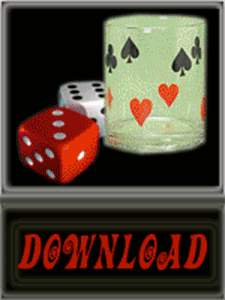Pokerwiner.com → Lessons of poker
Very sophisticated poker play can go considerably beyond the third level. An instance of such play came up at the Sahara in Las Vegas in a tough seven card stud game.
One player had:







Another had:







The pair of 6s bet on the end; the A,K raised with aces and kings; and the pair of 6s called with 6s up. On the surface it may seem as if the 6s up made a sucker play in betting, that the aces and kings took a big chance in raising a possible flush or trips, and that the 6s up made another sucker play in calling the raise. In a typical game, the two small pair would no doubt check on the end, and the ace and kings might very well check behind him to avoid a check-raise. However, the thinking of the two players in this game was much more complicated.
First, the 6 ![]() 4
4 ![]() was betting all the way; that player knew, therefore, that his opponent put him on a four-flush.
was betting all the way; that player knew, therefore, that his opponent put him on a four-flush.
So with two small pair he bet for value on the end because he knew his opponent thought he had a four-flush, and figured the opponent would call with one pair to snap off a bluff. The A,K took it a step further. He thought the pair of 6s might in fact be betting two pair for value because he knew the man with the two 6s thought he put him on a four-flush and that therefore the man with two 6s would bet two pair to get a call from one pair. So the A,K raised for value, thinking his opponent might think he was raising with only one pair.
The man with the 6s up was hoping exactly that, and given the size of the pot, he felt his hand had enough of a chance to justify calling the raise. It the pair of 6s’ first two up-cards had not been the same suit, the aces and kings would never have considered raising the bet on the end.
At best, he would only have had a crying call because with two small pair the other player would probably have checked since he couldn’t represent a flush draw. But with those diamonds showing each opponent was trying to outwit the other, and the aces and kings ended up getting the best of the situation.
The 6s up didn’t reraise, of course, representing a flush, because he knew that at that point the pot was so large his opponent would certainly call with something like aces up.
At the expert level of poker, the dialectic of trying to outwit your opponent can sometimes extend to so many levels that you must finally abandon psychology altogether and rely on game theory.
It is precisely when judgment fails that game theory becomes so useful. However, in ordinary play against good players, you should think at least up to the third level. First, think about what your opponent have. Second, think about what your opponent thinks you have. And third, think about what your opponent thinks you think the has. Only when you are playing against weak players, who might not bother to think about what you have and who almost certainly don’t think about what you think they have, does it not necessarily pay to go through such thought processes.
Against all other it is crucial to successful play, especially when deception is a big part of the game.



